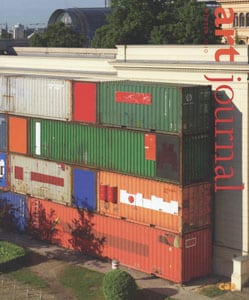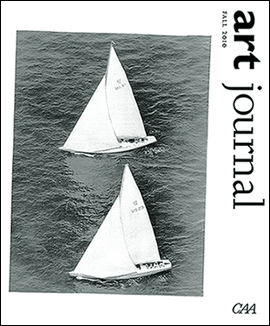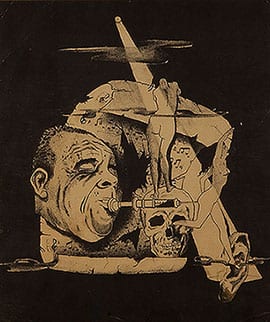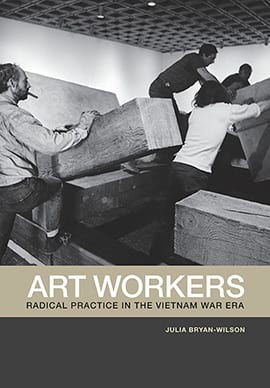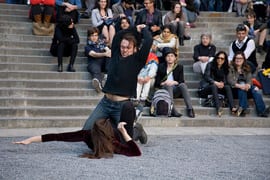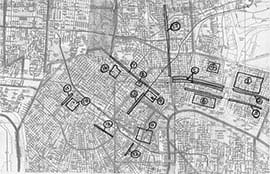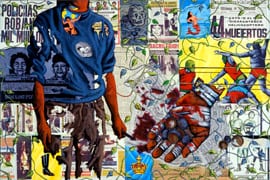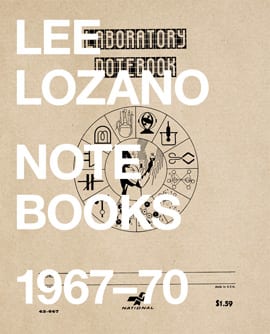In This Issue Katy Siegel, Something Totally Unpredictable, 5 Features Kerry James Marshall, Adrift, Infinity, or Oblivion, from Dailies, Inside…
Excerpts from the Graphic Novel !Women Art Revolution—A Secret History
By Lynn Hershman Leeson
I was a graduate student in Berkeley, California, during the tumultuous 1960s era of the Free Speech Movement. I felt an urgency to capture that moment, so, with a borrowed camera, I shot some of the people who were coming through my living room. Even though they included well-known people such as Timothy Leary, Allen Ginsberg, Jerry Rubin, and Phil Ochs, I concentrated on the stories of the yet-unknown women who were struggling to become artists.
Race to the Finish
By Katy Siegel
This is the first issue of Art Journal published in 2011, CAA’s Centennial year. We will mark the occasion throughout the year, helped by scholars and artists and a grant from the Andy Warhol Foundation. Our website launched in February, in response to the changing nature of art writing and publishing, and to the wish to attend to time-based and new media art.
Charles and Ray Eames in India
By Saloni Mathur
A photograph of the living room of the Eames house in the Pacific Palisades neighborhood of Los Angeles has proven rather puzzling to historians of design. It depicts the famous Case Study House as full of exotic collectibles. Hopi kachina dolls, seashells, craft objects, silk textiles from Nepal and Thailand, and elaborately patterned rugs from Mexico and India all crowd and assault their modernist frame.
City of Degenerate Angels: Wallace Berman, Jazz and Semina in Postwar Los Angeles
Ken D. Allan introduces two videos related to “City of Degenerate Angels: Wallace Berman, Jazz and Semina in Postwar Los Angeles,” his contribution to the Spring 2011 issue of Art Journal.
The Poverty of Poetry
Julia Bryan-Wilson, Art Workers: Radical Practice in the Vietnam War Era
By Michael Corris
The Art Workers’ Coalition (AWC) was formed in New York in 1969 in the wake of an incident in a museum. The Museum of Modern Art, New York (MoMA), mounted an exhibition titled The Machine as Seen at the End of the Mechanical Age. Within the exhibition was a work by the artist Vassilakis Takis.
InterAct: a reenacted interview
If the world’s a stage, then Liz Magic Laser becomes its director and all passersby are forced to perform. In 2009 Laser staged chase; the following year she produced Flight: in both works, action was registered on video and video begat action. To produce Interact, this project for Art Journal, Laser and her cast met at the East River Park Amphitheatre on two mornings last autumn: the first time to talk in the bleachers and the second time to relive the first conversation on stage.
X jxm vlr rpb pelria ilpb vlr
By Paul Chan
On the occasion of the upcoming release of the multimedia e-book version of Waiting for Godot in New Orleans: A field Guide (co-published by Badlands Unlimited and Creative Time Books), Paul Chan writes about some of the secrets hidden in plain sight within the maps and notes that make up the documentation of this multi-faceted work.
David Wojnarowicz: Against His Vanishing
By Steven Dubin
David Wojnarowicz was thrust into the national spotlight in 1989 when the National Endowment for the Arts rescinded its financial support for the catalogue accompanying the exhibition Witnesses: Against Our Vanishing, curated by Nan Goldin for Artists Space.
Something Totally Unpredictable
By Katy Siegel
The Art Journal Award, CAA’s annual prize for the best article published in the magazine, has been awarded to the current issue’s feature on Land art, a group of essays collected and introduced by Kirsten Swenson.
Soul-Beating
By David Reed
I was a student at the New York Studio School during the fall of 1966 and spring of 1967. The school was then located in a loft building on the northeast corner of Broadway and Bleecker Street. Draft deferments during the Vietnam War were not granted to students attending an art school, especially an unaccredited one like the Studio School.
Lee Lozano, Lee Lozano: Notebooks 1967–70
By Lauren O’Neill-Butler
“HISTORY DRAGS.” Of the many shrewd observations and witticisms that Lee Lozano (1930–1999) recorded in her notebooks, this one strikes deepest when considering the revival of interest in her work. Of course, we’ll never know her opinion on the widespread, international attention that has been lavished on her art and life over the last decade.

